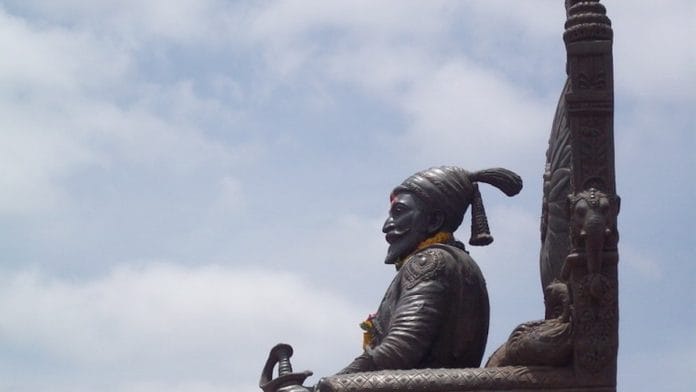The story of Chhatrapati Shivaji today is being written in stone and steel. His statues in Goa and Ladakh are symbols of Hindu assertion. But the hollow core of the warrior king’s politicisation is best captured by the 35-foot statue in Sindhudurg—the steel structure collapsed less than a year after it was erected.
Over the last decade, Shivaji has been promoted from a symbol of Maratha pride to an icon of Hindu nationhood. Kolkata’s Fort William has been renamed Vijay Durg after a naval base in Shivaji’s time. The Jawaharlal Nehru University is planning to start a ‘Centre of Excellence’ named after the king, dedicated to understanding the concept of ‘Akhand Bharat’.
Not that politicising Shivaji is a recent phenomenon. Centuries before Bal Thackeray formed a political party in Shivaji’s name, Jyotiba Phule wrote a powada (traditional Marathi ballad) casting the king as “a Shudra protector of his people”. Bal Gangadhar Tilak saw in Shivaji an anti-imperialist force, while Chhatrapati Shahu found his ancestor useful in inspiring Marathas to join the British Empire’s “battle line” in 1921.
Thanks to Shivaji’s pragmatism in all matters of governance—taxation, military strategy, even religion—he can be seen as both an anti-caste leader and the face of Hindutva. But the question remains: Does he warrant this attention?
A man of reform
The rise of Shivaji’s ‘Hindavi Swarajya’ wasn’t linear; there were major setbacks. When Mirza Raja Jai Singh besieged the Purandar fort in 1665 on behalf of Aurangzeb, Shivaji was forced to sue for peace. In the treaty that followed, he had to give up more than half the forts under his control. The following year, Aurangzeb invited him to the Mughal court in Agra—only to imprison him. But Shivaji escaped, rebuilt his strength, and won back most of the forts he had lost by 1670. Historian Anirudh Kanisetti called him “a man of extraordinary determination”.
“Today, we see the rise of the Marathas as inevitable. But the fact is, while various Maratha bands were militarily active before Shivaji—a lot of them worked for the Ahmednagar Sultanate—it was only Shivaji who had the imagination to conceive of a Maratha state,” he told ThePrint.
The ruler, who rose from the rank of a peasant warrior and became an emperor, had to get inventive. He used guerrilla tactics to win his first few battles. Even when his army grew, it remained agile—a direct contrast to the Mughals, who relied on numbers to overwhelm their opponents.
Shivaji relied on smaller numbers of cavalry forces, which made his army mobile and capable of surprise tactics. “If you see the general progress of the Mughal campaigns in the Deccan, this becomes their weakest point over and over again. They would invest huge amounts of money in taking a fort, and then effortlessly, Shivaji would capture it a few months later. And it became a never-ending cycle, bleeding the whole imperial treasury dry,” Kanisetti said.
The Maratha king also understood the importance of military modernisation. He wanted to equip his army with gunpowder. However, he had to depend on European companies to procure guns and cannons. While he did manage to buy 88 iron guns from the Portuguese, he didn’t have the same success with the British.
As he consolidated power, Shivaji began introducing administrative reforms. Under existing rulers, more than 50 per cent of the total agricultural produce was taken by the state. Well before his coronation in 1674, Shivaji had the lands under cultivation extensively surveyed so they could be taxed fairly. By 1671, he had reduced the tax to 2/5th or 33 per cent of total produce.
This zeal for reform can also be seen in Shivaji’s organisation of his court. During his coronation, his ministers were given Sanskrit titles instead of old Persian ones. He replaced Persian with Marathi as the language of the court.
“When Shivaji used Sanskrit in his administration, he was trying to link himself to this elite, courtly, Sanskritic Hindu tradition. He was being very remarkably intelligent in trying to link himself to the past and present his new kingdom as following in very old footsteps,” Kanisetti said.
Also read: Rajinikanth has Shivaji in his heart: Nitin Gadkari
Tryst with religion
Children in Maharashtra grow up hearing the story of a 15-year-old Shivaji cutting his finger at the Raireshwar temple, taking an oath to form a new kingdom. “Swarajya vhave hi Shreenchi ichchha (Hindavi Swarajya is God’s will),” goes the popular chant.
Sabhasad Bakhar, written by Krishnaji Anant Sabhasad, a contemporary of Shivaji, 17 years after the king’s death on 3 April 1680, is considered one of the most reliable biographies. The text has several mentions of the king dreaming of the goddess Bhavani. Shivaji also established a Bhavani temple at Pratapgad. However, his relationship with religion was a complex one.
Like other monarchs of his time, Shivaji needed divine sanction. However, he didn’t hesitate to break religious rules. Sensing the European threat, he established a navy, even though doing so was outlawed in Hinduism.
At the time of his coronation, Brahmins refused to crown him on account of his being a “Sudra”. While this was eventually resolved by tracing Shivaji’s lineage to the Rajput Sisodia clan of Mewar, Shivaji’s response at the time sums up his worldview.
“How is it that one who does good to the subjects and establishes the religion should have no right (to chhatra and sinhasan). He who has power is really a king.”
(Edited by Ratan Priya)






